
views
Using Unapproachable Body Language and Expressions

Cross your arms over your chest. This is an easy way to seem unapproachable. Simply stand or sit with your arms crossed in front of your chest. Holding this pose for a few minutes will send the signal that you do not want to be approached. For example, if you are trying to look unapproachable at school or work, cross your arms. This will send a nonverbal message that you do not want people to approach you. If you usually have your arms crossed, then this might not be very effective on its own. You might need to adjust your body in other ways.
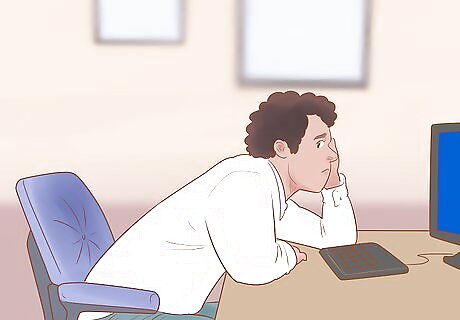
Slump when sitting or standing to indicate a lack of interest. Poor posture is another strong indicator that you are not interested in talking. Adopt a slumped posture while sitting or standing. Allow your abdomen to relax and round your back so that you are hunched over slightly. The more pronounced the posture, the stronger the signal will be! To send a subtle signal to someone, relax your posture and slump slightly. To send a stronger signal, slump over as much as possible while sitting or standing, such as by resting your upper body on a desk or table, or rounding your shoulders and looking down at the floor. Keep in mind that if you normally have bad posture, this might not be effective on its own. You may need to do other things to look unapproachable.
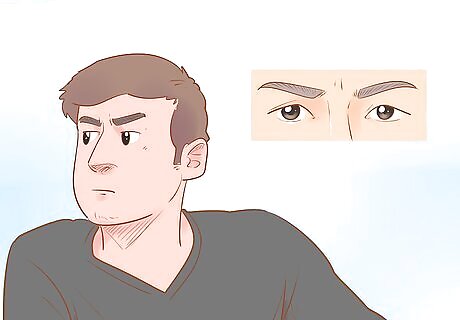
Frown or furrow your brow to look unapproachable. Smiling is the easiest way to seem approachable and invite someone to talk with you. Do not smile if you want to seem unapproachable! Scrunch up your eyebrows and frown at the same time send a stronger signal. Keep your face neutral if it is too hard to scowl or frown for a long period of time.
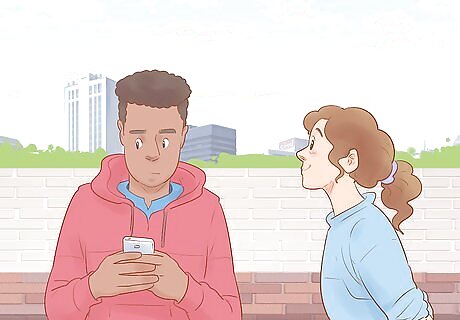
Avoid making eye contact. Locking eyes with someone sends the message that you are open to conversation. To seem unapproachable, avoid making eye contact with people, even if you can feel them looking at you. Look away, look down, or look at your phone. Do not look at the person! If you accidentally make eye contact, look away immediately. Then, turn and walk away to send an even stronger signal.

Stare at people intently. If you end up in a situation where you are face-to-face with someone, stare intently at them without blinking or looking away. This tends to make people feel uncomfortable. The person may consider this intense eye contact as a threat. After a few minutes of this, they may take the hint and leave. Make sure that you do not smile or indicate friendliness in another way. Keep your face neutral or scowl slightly as you stare. Do not talk very much or at all as you do this!
Using Barriers

Sit behind a desk or another type of barrier. Put a physical barrier between yourself and the person who you want to avoid. This sends the message that you are unapproachable. Sit behind a desk or table, or move into a different room to put a wall between you and the person. For example, if you are in a café, sit with your back to the wall and a table in front of you. If you are at work, sit behind a desk that faces the door or move your things so that you can work in a private room.
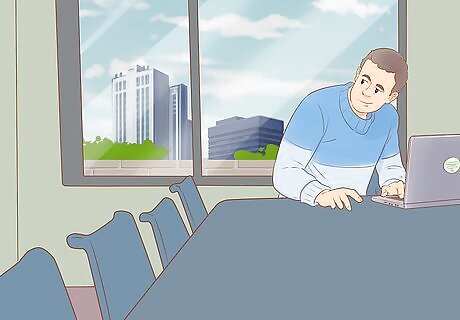
Stand alone in a far off part of the room. Choose the emptiest empty part of the room and sit or stand there. Standing on your own indicates that you don't want to be approached. People will assume that you want to be alone. This may deter them from coming closer. If you are in a restaurant, bar, or café and do not want to be approached, try sitting at a corner table away from other patrons. If you are at a dance or other social event, stand on the opposite side of the room from where most of the people are gathered.

Surround yourself with a group of people. Approaching someone who is standing in a big group of people is intimidating. If you are at a social event, work your way to the center of the crowd. Put as many bodies as possible between you and the person you want to avoid. For example, if you are at a dance or wedding, move to the center of the dance floor or join a large table of people. You don't have to talk or interact with them if you don't want to. Just join in the dancing or grab a seat at the table.
Using Standoffish Communication
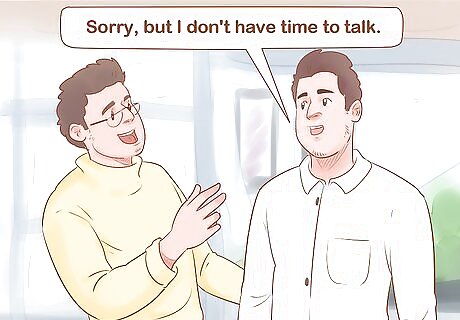
Say you don't want to talk. If someone approaches you and you don't want to talk, tell them that! Assert your boundaries and say that you are not interested in having a conversation. No matter what the situation, be direct and firm about not wanting to have a conversation. Even if you are very annoyed by the person, you can politely tell them you'd like to be left alone. You might say, “No thanks. I don't want to talk.” Say something like… “It's so nice of you to offer to keep me company, but I really need some alone time right now.” “I am trying to think through some things. Maybe we can talk another time.” It was nice to meet you, but I have to be on my way.”“Sorry, but I don't have time to talk.”

Give short answers to show that you don't want to talk. Refusing to engage in a conversation will send the message that you do not want to talk. Stick with short, 1-word answers to indicate that you don't want to continue the conversation. Also, avoid asking the other person any questions. For example, if someone approaches you and says, “Hi. My name is Todd. What's your name?” Simply reply with your name and do not offer any other information. Be quiet and continue giving 1-word responses to their questions. After a few minutes of this, the conversation may reach a dead end and the person may leave. If the person continues to ask questions, try saying something like, “It was nice to meet you, but I have to get going.” Then, say goodbye and leave.

Provide too much information to seem off-putting. People get uncomfortable when someone shares lots of personal information. If someone won't leave you alone, start talking about your recent breakup or tell them all about your problems with your landlord. Go into lots of detail and don't allow them to interject. Just keep talking! This should make them uncomfortable and they will likely go away after a few minutes of this. For example, you could say something like, “My ex would hate this place. She was such a snob when it came to bars! If they didn't have a fancy drink menu and mood lighting, I was in for a terrible night. There was this one time when she…” And continue to rant about your ex until the person has had enough and leaves. If this does not work either, try saying something like, “Well, thanks for listening to me, but I have to be on my way now! Goodbye!”




















Comments
0 comment